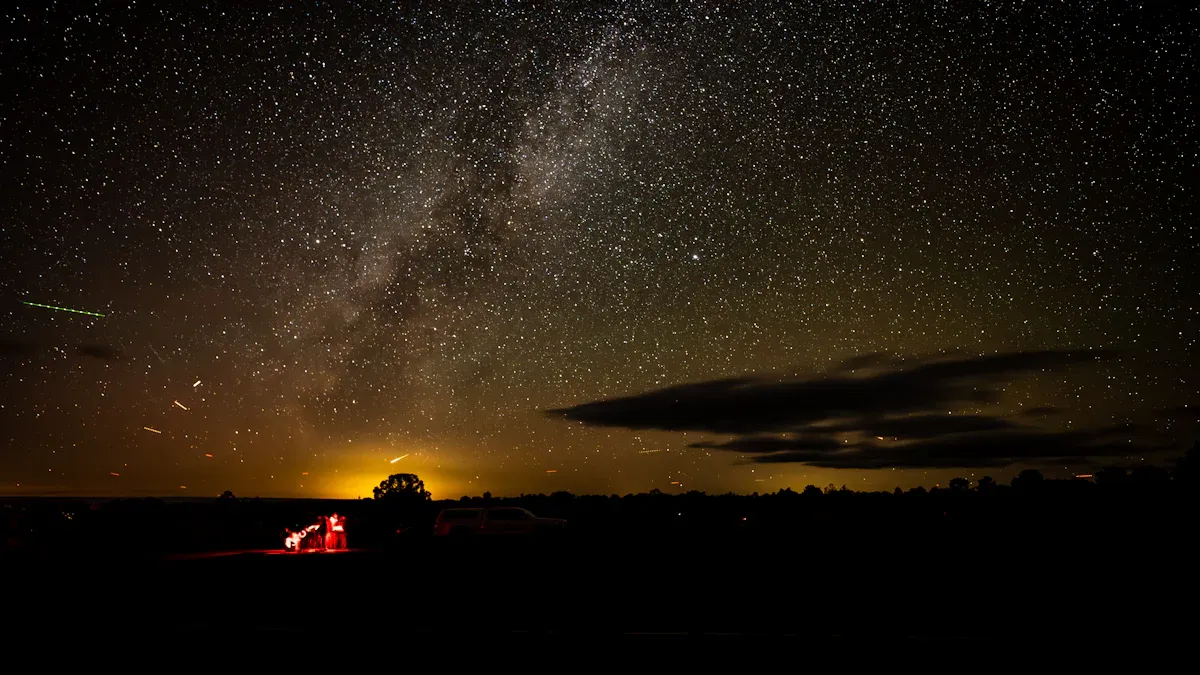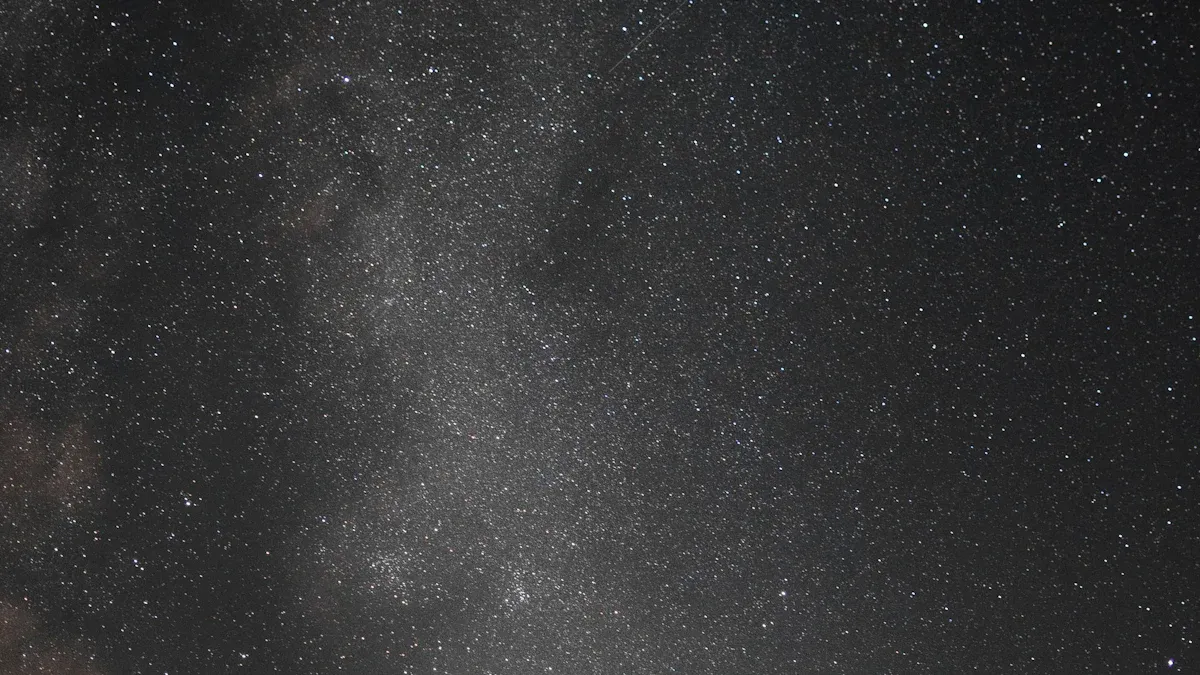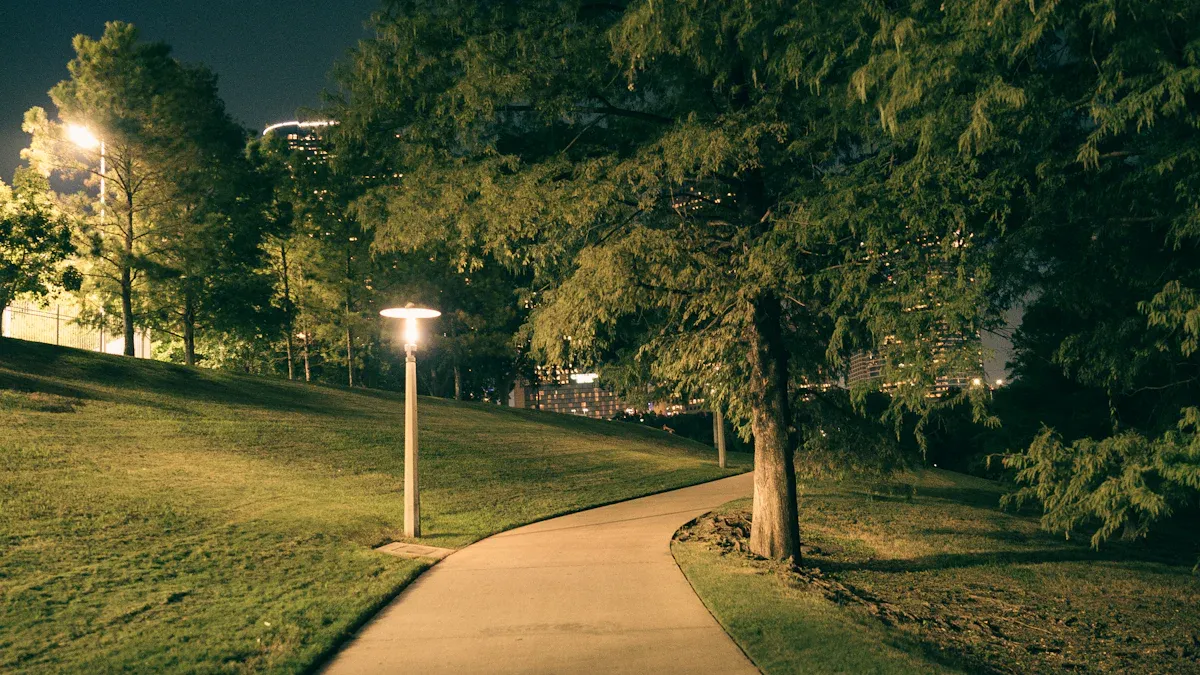Dark Sky Outdoor Lighting: Reducing Light Pollution While Maintaining Functionality

Imagine looking at the night sky and seeing fewer stars. Light pollution makes the sky less beautiful and harms nature, people, and energy use. Scientists found that stars visible at night dropped by 7-10% yearly from 2011 to 2022. A place with 250 stars might now see only 100. Bright lights, including those from traditional outdoor lighting, disturb animals and waste energy. Bennie et al. (2014) warned that artificial light, such as that from standard products, hurts wildlife.
Dark Sky Outdoor Lighting can help fix this problem. Fully-covered lights, soft-colored LED lights, and solar lights lower glare and save the night sky. These products work well and protect the planet.
Key Takeaways
Too much light hurts nature and people. Cutting it helps sleep and protects animals.
Use lights with covers that point light down. This stops glare and keeps the sky dark.
Pick warm-colored LED lights (2700K-3000K). They save energy, feel cozy, and lower light pollution.
Use smart lighting systems to save power. These adjust brightness and timing to avoid waste.
Teach your community about light pollution. Sharing knowledge can lead to better lighting choices together.
The Problem with Traditional Outdoor Lighting

How Traditional Lighting Adds to Light Pollution
Old outdoor lights are often poorly made. This causes extra light pollution. Badly designed lights shine in all directions, even up. This wasted light makes the night sky brighter and hides stars. Common examples of this problem include:
Streetlights that shine outward and upward.
Neon signs glowing too brightly in cities.
Building lights spreading light beyond their target.
Research shows fully covered lights can cut light pollution a lot. These lights point light downward where it’s needed. They can lower sky brightness by up to 75%. Picking better lights helps keep the night sky beautiful.
Effects of Light Pollution on Nature and Health
Light pollution doesn’t just ruin the night sky. It also hurts nature and people. Too much artificial light confuses animals and plants. For example, night animals can’t hunt or move easily. Some plants grow differently because of bright lights.
People are affected too. Bright lights can mess up your body clock. This can cause sleep problems and stress. Studies show these effects:
Study Title | Key Findings |
|---|---|
Light Pollution and Its Effect on the Environment | 90% had health problems; 70% had trouble sleeping; 60% saw changes in animal behavior. |
Light Pollution and Its Effects on Human Health and the Environment: A Review | Hurts body clocks, causes sleep issues, and affects animals and plants. |
Limiting the Impact of Light Pollution on Human Health, Environment, and Stellar Visibility | Shares ways to reduce harm to people, animals, and the night sky. |
Fixing these problems helps people, animals, and the night sky stay healthy and beautiful.
What Makes Dark Sky Outdoor Lighting Different?

Key Features of Dark Sky-Compliant Lighting
Dark Sky Outdoor Lighting is special because it reduces light pollution. It still works well while being eco-friendly. Its design focuses on shielding, warm light, and smart use. These features make sure light goes only where it’s needed. This helps avoid waste and protects nature.
Feature/Principle | Dark Sky Outdoor Lighting | Traditional Lighting Systems |
|---|---|---|
Lighting Controls | Helps save energy and cut light pollution | Often lacks smart controls |
Light Pollution | Reduces glare, skyglow, and wasted light | Usually adds to light pollution |
Design Principles | Follows rules for responsible outdoor lighting | May not follow any specific rules |
Spectral Emission | Uses soft, warm light (2700K-3000K) | Often uses harsh, bright light |
Compliance | Meets modern lighting laws | May not meet updated rules |
Shielding is key to cutting skyglow. Fully covered lights can lower sky brightness by 90%. They keep light focused downward where it’s needed. Warm-colored LEDs (2700K-3000K) are softer and feel more natural. These lights protect the night sky and make outdoor spaces look better.
Dark Sky Outdoor Lighting also uses smart controls. These let you adjust brightness, timing, and direction. This saves energy and avoids wasting light. By following the Five Principles of Responsible Outdoor Lighting, these lights meet today’s rules and support green practices.
Benefits for Communities, Ecosystems, and Energy Efficiency
Using Dark Sky Outdoor Lighting helps people, nature, and energy use. Shielded lights and warm LEDs reduce glare and wasted light. This makes neighborhoods safer and more comfortable. Smart systems with motion sensors and timers save energy and cut costs.
Shielded lights and soft wavelengths protect animals and plants. Night animals can hunt and move better. Plants grow naturally without bright lights.
Energy-saving LEDs copy natural light and use less power. Dimming features save even more energy while keeping areas safe.
Communities enjoy better visibility and less glare, improving safety and life quality. Nature thrives when artificial light doesn’t disturb animals or plants. Saving energy lowers costs and helps fight climate change.
Choosing Dark Sky Outdoor Lighting helps the planet, saves money, and keeps the night sky beautiful. These lights are both useful and eco-friendly, making them perfect for today’s outdoor spaces.
Strategies for Using Dark Sky Outdoor Lighting
Choose Fully-Shielded Fixtures
Fully-shielded fixtures are great for cutting light pollution. These lights point downward, lighting only the needed area. They stop light from going up or out, reducing skyglow and glare. This helps keep the night sky clear and improves outdoor safety.
Towns using fully-shielded fixtures see big improvements. For example:
Town | Benefits |
|---|---|
Flagstaff, Arizona | Clear skies, better living, support for local observatory. |
Boulder, Colorado | Better night skies, energy savings with soft lighting. |
Helper, Utah | Boost in dark sky tourism, energy-saving streetlights, education on light pollution. |
Sedona, Arizona | Popular dark sky tourism, natural beauty preserved, public learning events. |
Westcliffe & Silver Cliff, Colorado | Dark sky tourism, local business support, community learning about light pollution. |
Jackson Hole, Wyoming | Eco-tourism growth, teamwork with parks to protect wildlife. |
Using fully-shielded fixtures helps nature, local businesses, and the night sky.
Use Warm-Colored LEDs
Warm-colored LEDs (2700K-3000K) are softer and better for nature. These lights don’t bother animals and reduce glare. Unlike bright white lights, they make outdoor spaces feel cozy and welcoming.
Switching to warm LEDs saves energy too. Key facts include:
Warm LEDs use 75% less energy than old bulbs.
LEDs last 25 times longer than regular bulbs.
By 2035, LED savings could match the power of 92 plants.
Choosing warm LEDs lowers light pollution, saves money, and helps the planet.
Add Smart Lighting Controls
Smart lighting controls make outdoor lighting smarter and greener. These systems let you control brightness, timing, and direction. Lights only turn on when needed, saving energy and cutting waste. Motion sensors light up when movement happens, and timers turn lights off during quiet hours.
Smart lighting has clear benefits:
Smart systems cut energy use and carbon emissions by using lights only when needed.
Each smart streetlight can save over 1,200 lbs of carbon yearly.
Regular streetlights stay on all the time, but smart ones save energy by working only when required.
Smart lighting controls are efficient and eco-friendly. They reduce light pollution while keeping outdoor spaces functional.
Place Lights Carefully to Reduce Glare
Where you put outdoor lights matters a lot. Badly placed lights can cause bright reflections. This makes it hard to see and harms nature. Planning light placement well improves safety and protects the night sky.
Here are some simple tips for placing lights:
Architectural Design: Think about how light hits surfaces. Placing lights under roofs or overhangs helps aim light downward. This stops light from spreading to areas it shouldn’t.
Lighting Design: Use two types of lighting: task and ambient. Task lights brighten specific spots like paths or doors. Ambient lights give soft, overall brightness. Place them to avoid glare and reflections for a cozy outdoor space.
Adjustable Lighting Systems: Pick lights you can adjust. These let you change brightness or direction. For example, dim lights at night or angle them away from neighbors’ windows.
Always light only the areas that need it. Don’t place lights where they shine in eyes or bounce off shiny things. This keeps glare low and spaces welcoming.
Tip: Walk around your yard at night before adding lights. Look for spots where light might glare or spill upward. Adjust plans to aim light down and keep it focused.
By placing lights carefully, you can have a bright yard that’s eco-friendly. Small changes in placement help cut light pollution and save the night sky.
Practical Steps for Using Dark Sky Outdoor Lighting
Check Your Current Lighting
Start by looking at your outdoor lights. Find fixtures that shine in all directions or cause glare. These lights waste energy and add to light pollution. Notice where light spills upward or sideways instead of lighting the ground.
Research shows checking lighting can improve how spaces feel and work. For example:
Study | Findings |
|---|---|
Sloane et al. (1998) | |
La Garce (2002) | Steady light reduced upsetting behaviors in Alzheimer’s patients. |
Lovell et al. (1995) | Bright morning light helped calm elderly dementia patients. |
Walch et al. (2005) | More sunlight lowered stress and cut pain medicine costs. |
Beauchemin & Hays (1996) | Light exposure shortened hospital stays for depressed patients. |
Satlin et al. (1992) | Bright light improved sleep for older adults. |
Spotting problem lights helps you decide what to fix or replace. Choose lights that follow Dark Sky Outdoor Lighting rules.
Pick Certified Dark Sky Products
When buying new lights, choose ones with dark sky certifications. These products are made to lower light pollution. Certifications ensure the lights meet rules like shielding, dimming, and uplight limits.
Certification/Standard | Description |
|---|---|
DarkSky Approved | Third-party certification for lights that cut light pollution. |
IES BUG Rating | Rates Backlight, Uplight, and Glare for outdoor use. |
Performance Criteria | Includes rules for shielding, dimming, and safety. |
Certified lights save energy, improve safety, and protect the night sky. Picking these products helps the environment and keeps spaces eco-friendly.
Work with Local Rules and Groups
Team up with local groups and follow area rules to reduce light pollution. Many places have programs to protect the night sky. Joining these efforts can make a bigger difference and keep you within the law.
For example, the Oregon Dark Sky Network united officials, businesses, and locals to promote dark sky ideas. In Chile, a National Lighting Standard protects nature and supports astronomy. Residents of the Columbia River Gorge push for rules to save the night sky.
Location | Description |
|---|---|
Oregon | Officials, businesses, and locals worked together to promote dark sky ideas. |
Chile | National rules protect nature, astronomy, and health. |
Columbia River Gorge | Locals support policies to fight light pollution and save the night sky. |
By joining these programs, you help protect the night sky and care for the environment.
Promote Awareness and Community Adoption
Helping your community learn about light pollution can make a big difference. Many people don’t know how artificial light harms nature, animals, and people. Teaching others can inspire them to use better lighting.
Start by hosting events to share information. These events can show neighbors how light pollution affects the world. For example, Flagstaff, Arizona, showed that informed communities support solutions. Astronomy clubs can also help. They can host stargazing nights to show how clear skies look and explain how good lighting keeps them that way.
Tip: Work with schools, libraries, or local groups to reach more people. Workshops and talks can teach others about the benefits of dark sky lighting.
It’s also important to clear up wrong ideas. Some think brighter lights make places safer, but that’s not always true. Too much light or poorly aimed lights can cause glare, making it harder to see. Awareness programs can explain how dark sky lighting improves safety and saves energy.
Here are easy ways to spread the message:
Post on social media about why dark sky lighting matters.
Hand out flyers or brochures in your area.
Ask local businesses to use dark sky-friendly lights.
Support rules that protect the night sky.
When people understand why dark sky lighting is important, they’re more likely to use it. By working together, you can save the night sky and create a better, healthier world for everyone. 🌌
The Future of Dark Sky Outdoor Lighting
New Ideas in Lighting Technology
The future of dark sky lighting is exciting with new ideas. These changes aim to cut light pollution while staying eco-friendly and useful. Here are some trends shaping the future:
Color Temperature Changes: Lights now use softer colors (2200-3000K) to reduce skyglow. Some projects even use amber lights to lower blue light effects.
Smart Lighting Systems: New systems adjust brightness and color based on conditions. These save energy and are better for the environment.
Wildlife-Friendly Lights: Special lights, like sea turtle-safe ones, protect animals. Human-friendly designs also meet dark sky rules while helping nature.
These updates keep the night sky clear and make outdoor spaces safer and greener.
How Rules and Advocacy Help
Rules and advocacy are key to spreading dark sky lighting. Groups and governments are working hard to fight light pollution:
DarkSky International teamed up with nine countries to protect the night sky.
In New Zealand, over 1,000 streetlights were replaced with 2200K LEDs. They’re also making laws to stop light pollution.
In Texas, the Greater Big Bend Dark Skies Reserve was created. Counties worked together to follow dark sky lighting rules.
These efforts show how teamwork can make a big difference. Supporting these actions helps save the night sky for the future.
How You Can Help Save the Night Sky
You can help protect the night sky with simple actions. Here’s how:
Support smart lighting to cut light pollution in your area.
Join local programs like Lights Out Georgia to protect animals during migration.
Work with your community to promote dark sky lighting and better rules.
Groups like the International Dark-Sky Association offer tools to help you. Supporting dark sky programs also teaches others about light pollution.
Tip: Ask your neighbors to use dark sky-friendly lights. Small changes can make a big difference in saving the night sky.
By taking these steps, you help reduce light pollution. This ensures future generations can enjoy a starry night sky. 🌌
Using Dark Sky Outdoor Lighting helps cut light pollution and care for nature. Pick shielded lights, soft-colored LEDs, and smart systems. These choices make outdoor spaces useful and keep the night sky clear. Begin by checking your home’s lights and inspire others to do the same. Each small action helps the Earth and brightens the sky. Together, we can protect the beauty of starry nights. 🌌
Tip: Look at the stars tonight and imagine them shining brighter. Your efforts can make this dream come true.
FAQ
What is light pollution, and why is it important?
Light pollution happens when artificial lights brighten the night sky too much. It blocks stars, confuses animals, and wastes energy. Reducing it helps nature, saves money, and brings back starry skies. 🌌
How do I know if my outdoor lights are dark sky-friendly?
Check if your lights are covered and aim downward. They should use soft-colored LEDs (2700K-3000K) and avoid glare or upward light. Look for labels like "DarkSky Approved" to be sure.
Are dark sky lights more expensive than regular ones?
Not always. Some dark sky lights may cost more at first. But they save money later by using less energy and lasting longer than regular bulbs.
Can dark sky lighting make places safer?
Yes! Well-designed lights reduce glare and improve visibility. Shielded lights aim light where it’s needed, making walking or driving safer without over-lighting.
How can I get my community to use dark sky lighting?
Start by teaching others. Share how light pollution harms nature and how dark sky lighting helps. Plan events, work with local groups, and support rules to protect the night sky. Small actions can make a big difference!
Tip: Show your neighbors how dark sky lighting saves energy and improves safety. Set an example with your own outdoor lights.
See Also
Selecting Ideal Brightness and Coverage for Outdoor Lighting
Transform Your Outdoor Area with RGB Flood Lighting Effects
Top Five LED Outdoor Lighting Options for Enhanced Safety
Comparing LED Streetlights and Traditional Lights for Efficiency
Modern LED Highway Lighting: Enhancing Safety and Efficiency

